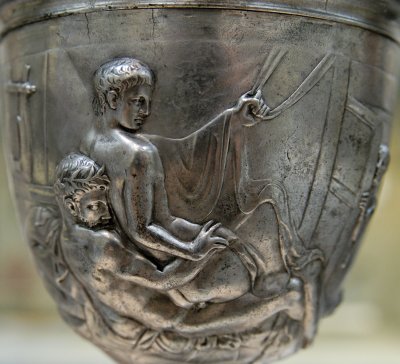 Controversy bred outcry; debates raged on radio shows, broadsheets and television up and down the country. But all the British Museum had done was buy a small, silver Roman cup – a beautiful cup at that, with its finely-etched details having been kept in great condition. What was the public’s problem? Why did so many people object to their national museum stumping up 1.8m for a stunnning piece of ancient art?
Controversy bred outcry; debates raged on radio shows, broadsheets and television up and down the country. But all the British Museum had done was buy a small, silver Roman cup – a beautiful cup at that, with its finely-etched details having been kept in great condition. What was the public’s problem? Why did so many people object to their national museum stumping up 1.8m for a stunnning piece of ancient art?
The answer lay in the cup’s decoration. The Warren Cup, named after its best-known modern owner Edward Perry Warren, is a Roman skyphos (drinking cup), dating from between 1-20 AD. The controversial cup comprises two highly-charged homosexual acts.
Side A shows a young man (the passive participant, or eromenos) lowering himself onto an older man (the active erastes) with a rope. A third man watches on voyeuristically from behind a door, most possibly a slave. Side B contains a similar scene, with two younger men engaging in anal sex. Two handles would have been stationed at the rim of the cup, probably a banqueting centrepiece, but have been lost over time.
The lush background and decorative furniture on both sides of the cup suggest Greek craftsmanship. It is thought to have first been discovered near Jerusalem, a hoarded casualty of the First Roman-Jewish War, though it’s a story without much historical clout. Whatever the truth is, 19th century American collector Warren, a staunch advocate of Greek homoeroticism, purchased the cup in 1911 for 2,000 and promptly hid it from view. Just like homosexuality at the time, the Warren Cup was to be a clandestine affair, held in privacy to hide its ignominy.
 This would be the cup’s lot for most of the 20th century, mirroring attitudes to homosexuality across the western world. In the 1950s the cup was even refused entry to the US. The British Museum refused a purchase, thinking it unexhibitable. Yet it would be the 1980s, when opinions first swayed against homophobia, that the cup would re-emerge into the public eye.
This would be the cup’s lot for most of the 20th century, mirroring attitudes to homosexuality across the western world. In the 1950s the cup was even refused entry to the US. The British Museum refused a purchase, thinking it unexhibitable. Yet it would be the 1980s, when opinions first swayed against homophobia, that the cup would re-emerge into the public eye.
And in 1999 the British Museum took one of its biggest leaps (and U-turns) in recent history, when it made the Warren Cup its most expensive single item. Since then it has joined many other racy relics in sexual exhibitions across the country, extolling the libertine sexual values of our Roman forebears.
The Warren Cup may just be the ancient world’s perfect polemic for modern attitudes to homosexuality. Just as western society has opened up, so the cup has crawled out from under a blanket of finger-pointing and outrage to become one of the BM’s highlight artefacts. Incidentally the Romans had no word for homosexuality, seeing it as an act rather than a label. There are many things the Romans taught us. Sadly this is something we forgot.




